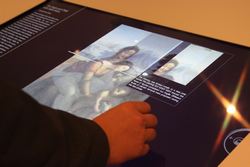Joint stakeholder efforts shape tomorrow’s digital culture
The digitalisation of cultural heritage is one of the main challenges facing European museums and other cultural institutions. Libraries, museums and heritage sites are increasingly experimenting and embracing new technologies able to turn formerly passive audiences into active practitioners of culture. This process is key not only to protecting art and architecture from the ravages of time, but also to drawing in a new generation of enthusiasts who have been brought up surrounded by tactile devices and the Web 2.0. There is one thing, however, that hinders the development of this new culture consumption pattern: the lack of cross-fertilisation. Completed in November 2015, SMARTCULTURE was a three-year, -project involving cooperation between 13 partners and bringing together eight regional research centres from across Europe. What these partners have in common is their interest in culture, heritage and ICT: Most of the regions involved have a very high population, a very rich cultural heritage with the likes of the Louvre-Lens, Museo Guggenheim and Museo del Prado, as well as dynamic production of contents. Some are European leaders in information & communication and creative & cultural industries, and all have a strong relationship with ‘European capitals of culture’ (ECoC) whether previous winners or candidates. ‘The Digital Cultural Heritage sector necessitates a wide range of competences,’ says Anca Draghici, coordinator of the project for French technological hub Euratechnologies. ‘Consequently, the cross-fertilisation between ICT enterprises, creative and cultural industries (especially SMEs), research stakeholders, cultural institutions and public authorities across Europe through mutual learning and mutual mentoring becomes necessary for a wider development of the market.’ Through their ‘Coordination and support action’ (CSA), SMARTCULTURE partners promoted the creation of engaging digital experiences for people looking to access cultural resources. ‘These relationships not only provided an opportunity to open up the hidden social and economic potential of heritage and cultural collections through digital technologies, but also impacted on the quality of life of culturally diverse citizens,’ points out Draghici. Extensive resources to help digital culture thrive Among the various challenges the digital cultural heritage sector has to face, Draghici mentions three which should be addressed immediately: education and awareness-raising to prevent citizens who currently do not have easy access to culture and technologies from being penalised twice; the harmonisation of European policies in terms of access to content; and the providing of clear answers to all questions related to intellectual property. To help the sector rise to these challenges, the SMARTCULTURE consortium produced a total of 26 analyses and reports. These include: the inventory of Digital Cultural Heritage stakeholders, infrastructures, initiatives and tools across the eight partner regions; a joint action plan for EU institutions and a business plan; a human potential analysis in the Digital Cultural Heritage field; and a Strategic Research Agenda. The project also provided technical and political recommendations for an international strategy on the digital agenda. Other key achievements include the organisation of events and mutual mentoring workshops across Europe and beyond, the enhancement of a network of 2 500 professionals, and the design of a set of tools dedicated to quadruple helix stakeholders — Public authorities, Academia, Cultural institutions and Business. ‘The insights and examples provided in the SMARTCULTURE documents testify to a great variety and ingenuity in the ways that cultural heritage materials — pre-digital or digital — are put to use to enliven communities while stimulating research and innovation. This is very encouraging and constitutes a solid base for further developments and for bringing more regions into collaborative projects,’ Draghici says. 2015 and beyond All stakeholders — public administration, private and public companies, academies and the general public — are set to benefit from the project outcomes. The project’s reports have been delivered to the European Commission, which will use the data for its future strategies and calls. In addition, the partner regions will pursue SMARTCULTURE dissemination through four main channels: the brochure ‘New Technologies and Digital Growth in Cultural and Creative Industries: 8 cases studies’, the project website, social media channels and the project’s research publications. The project’s end does not however mean that SMARTCULTURE’s research efforts are over. ‘Academic SMARTCULTURE partners from Birmingham University and the International University of Languages and Media in Milan also envisage a common publication in 2016 through Routledge to bring together the scientific contributions that have emerged from the project and to further explore the innovative concept of the smart culture economy,’ Draghici explains. ‘It will investigate, through European case studies and contextual cross-cutting research, the current and emergent environment for a smart culture based on the coproduction of interactive digital cultural heritage, a capitalisation on local expertise, and a highlighting of regional heritage and its distinctiveness to wider publics.’ The volume will have a theoretical part divided into two chapters: one dedicated to the concept of Culture 3.0 and one on the innovation capacities of the SMARTCULTURE Quadruple Helix approach. This theoretical part will be followed by regional case studies of best practice in smart culture initiatives, as well as clusters exploring regional dynamics, innovation mechanisms, and their economic and policy implications.
Keywords
Digitalisation, cultural heritage, cultural resources



